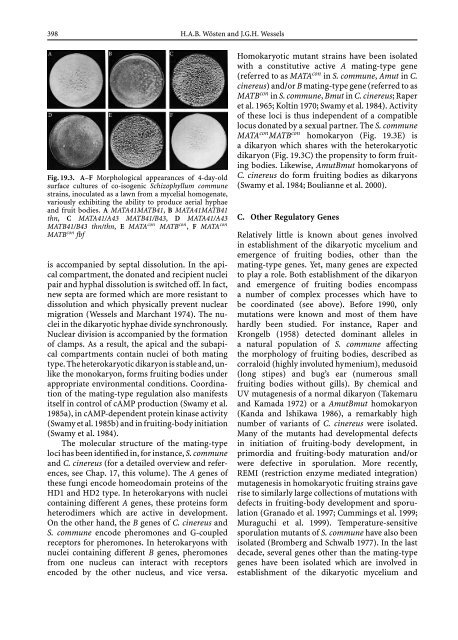Growth, Differentiation and Sexuality
Growth, Differentiation and Sexuality
Growth, Differentiation and Sexuality
You also want an ePaper? Increase the reach of your titles
YUMPU automatically turns print PDFs into web optimized ePapers that Google loves.
398 H.A.B. Wösten <strong>and</strong> J.G.H. Wessels<br />
Fig. 19.3. A–F Morphological appearances of 4-day-old<br />
surface cultures of co-isogenic Schizophyllum commune<br />
strains, inoculated as a lawn from a mycelial homogenate,<br />
variously exhibiting the ability to produce aerial hyphae<br />
<strong>and</strong> fruit bodies. A MATA41MATB41, B MATA41MATB41<br />
thn, C MATA41/A43 MATB41/B43, D MATA41/A43<br />
MATB41/B43 thn/thn, E MATA con MATB con , F MATA con<br />
MATB con fbf<br />
is accompanied by septal dissolution. In the apical<br />
compartment, the donated <strong>and</strong> recipient nuclei<br />
pair <strong>and</strong> hyphal dissolution is switched off. In fact,<br />
new septa are formed which are more resistant to<br />
dissolution <strong>and</strong> which physically prevent nuclear<br />
migration (Wessels <strong>and</strong> Marchant 1974). The nuclei<br />
in the dikaryotic hyphae divide synchronously.<br />
Nuclear division is accompanied by the formation<br />
of clamps. As a result, the apical <strong>and</strong> the subapical<br />
compartments contain nuclei of both mating<br />
type. The heterokaryotic dikaryon is stable <strong>and</strong>, unlike<br />
the monokaryon, forms fruiting bodies under<br />
appropriate environmental conditions. Coordination<br />
of the mating-type regulation also manifests<br />
itself in control of cAMP production (Swamy et al.<br />
1985a), in cAMP-dependent protein kinase activity<br />
(Swamy et al. 1985b) <strong>and</strong> in fruiting-body initiation<br />
(Swamy et al. 1984).<br />
The molecular structure of the mating-type<br />
loci has been identified in, for instance, S. commune<br />
<strong>and</strong> C. cinereus (for a detailed overview <strong>and</strong> references,<br />
see Chap. 17, this volume). The A genes of<br />
these fungi encode homeodomain proteins of the<br />
HD1 <strong>and</strong> HD2 type. In heterokaryons with nuclei<br />
containing different A genes, these proteins form<br />
heterodimers which are active in development.<br />
On the other h<strong>and</strong>, the B genes of C. cinereus <strong>and</strong><br />
S. commune encode pheromones <strong>and</strong> G-coupled<br />
receptors for pheromones. In heterokaryons with<br />
nuclei containing different B genes, pheromones<br />
from one nucleus can interact with receptors<br />
encoded by the other nucleus, <strong>and</strong> vice versa.<br />
Homokaryotic mutant strains have been isolated<br />
with a constitutive active A mating-type gene<br />
(referred to as MATA con in S. commune, Amut in C.<br />
cinereus) <strong>and</strong>/or B mating-type gene (referred to as<br />
MATB con in S. commune, Bmut in C. cinereus;Raper<br />
et al. 1965; Koltin 1970; Swamy et al. 1984). Activity<br />
oftheselociisthusindependentofacompatible<br />
locus donated by a sexual partner. The S. commune<br />
MATA con MATB con homokaryon (Fig. 19.3E) is<br />
a dikaryon which shares with the heterokaryotic<br />
dikaryon (Fig. 19.3C) the propensity to form fruiting<br />
bodies. Likewise, AmutBmut homokaryons of<br />
C. cinereus do form fruiting bodies as dikaryons<br />
(Swamy et al. 1984; Boulianne et al. 2000).<br />
C. Other Regulatory Genes<br />
Relatively little is known about genes involved<br />
in establishment of the dikaryotic mycelium <strong>and</strong><br />
emergence of fruiting bodies, other than the<br />
mating-type genes. Yet, many genes are expected<br />
to play a role. Both establishment of the dikaryon<br />
<strong>and</strong> emergence of fruiting bodies encompass<br />
a number of complex processes which have to<br />
be coordinated (see above). Before 1990, only<br />
mutations were known <strong>and</strong> most of them have<br />
hardly been studied. For instance, Raper <strong>and</strong><br />
Krongelb (1958) detected dominant alleles in<br />
a natural population of S. commune affecting<br />
the morphology of fruiting bodies, described as<br />
corraloid (highly involuted hymenium), medusoid<br />
(long stipes) <strong>and</strong> bug’s ear (numerous small<br />
fruiting bodies without gills). By chemical <strong>and</strong><br />
UV mutagenesis of a normal dikaryon (Takemaru<br />
<strong>and</strong> Kamada 1972) or a AmutBmut homokaryon<br />
(K<strong>and</strong>a <strong>and</strong> Ishikawa 1986), a remarkably high<br />
number of variants of C. cinereus were isolated.<br />
Many of the mutants had developmental defects<br />
in initiation of fruiting-body development, in<br />
primordia <strong>and</strong> fruiting-body maturation <strong>and</strong>/or<br />
were defective in sporulation. More recently,<br />
REMI (restriction enzyme mediated integration)<br />
mutagenesis in homokaryotic fruiting strains gave<br />
rise to similarly large collections of mutations with<br />
defects in fruiting-body development <strong>and</strong> sporulation<br />
(Granado et al. 1997; Cummings et al. 1999;<br />
Muraguchi et al. 1999). Temperature-sensitive<br />
sporulation mutants of S. commune have also been<br />
isolated (Bromberg <strong>and</strong> Schwalb 1977). In the last<br />
decade, several genes other than the mating-type<br />
genes have been isolated which are involved in<br />
establishment of the dikaryotic mycelium <strong>and</strong>

















